Food Industry Pulsed Electric Field (PEF) Systems Market Size 2025-2029
The food industry pulsed electric field (pef) systems market size is valued to increase USD 1.35 billion, at a CAGR of 45.7% from 2024 to 2029. Increased need for food sterilization will drive the food industry pulsed electric field (pef) systems market.
Major Market Trends & Insights
- Europe dominated the market and accounted for a 54% growth during the forecast period.
- By Application - Liquid food segment was valued at USD 49.90 billion in 2023
- By Type - 30-50 kV/cm segment accounted for the largest market revenue share in 2023
Market Size & Forecast
- Market Opportunities: USD 1.00 million
- Market Future Opportunities: USD 1352.60 million
- CAGR : 45.7%
- Europe: Largest market in 2023
Market Summary
- The market represents a dynamic and innovative sector, driven by the continuous advancements in food processing technologies. PEF systems utilize electric fields to disrupt cell membranes, enabling various applications such as food pasteurization, juice clarification, and extraction of bioactive compounds. Core technologies like high voltage and intensity pulsed electric fields are at the forefront of this market, offering advantages like minimal thermal damage and energy efficiency. The service types or product categories within the PEF systems market include equipment sales, installation, and maintenance services. The increasing need for food sterilization and the introduction of new PEF systems are major drivers for market growth.
- However, the high initial cost for setting up PEF systems poses a challenge for smaller food processing companies. According to a recent study, the global PEF systems market is projected to grow significantly over the next decade, with a notable increase in adoption rates in Europe and North America. For instance, the European Union has set a target of reducing food waste by 50% by 2030, which is expected to boost the demand for PEF systems in the region. Furthermore, the market's evolving nature is reflected in the ongoing research and development efforts to expand the applications of PEF systems in various food industries.
- In related markets such as the water treatment and pharmaceutical industries, PEF technology is gaining popularity for its ability to inactivate microorganisms and enhance the extraction of valuable compounds. This cross-industry growth underscores the potential of PEF systems as a versatile and sustainable technology.
What will be the Size of the Food Industry Pulsed Electric Field (PEF) Systems Market during the forecast period?
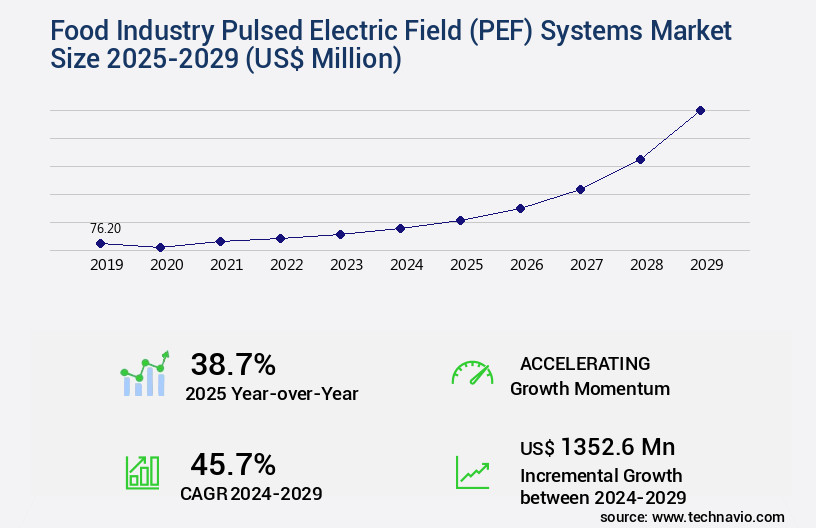
Get Key Insights on Market Forecast (PDF) Request Free Sample
How is the Food Industry Pulsed Electric Field (PEF) Systems Market Segmented and what are the key trends of market segmentation?
The food industry pulsed electric field (pef) systems industry research report provides comprehensive data (region-wise segment analysis), with forecasts and estimates in "USD million" for the period 2025-2029, as well as historical data from 2019-2023 for the following segments.
- Application
- Type
- End-user
- Food processing companies
- Beverage manufacturers
- Dairy producers
- Meat and seafood processors
- Fruit and vegetable packers
- Geography
- North America
- Europe
- APAC
- South America
- Rest of World (ROW)
By Application Insights
The liquid food segment is estimated to witness significant growth during the forecast period.
PEF systems have gained significant traction in the food industry, particularly in the processing of liquid food products. Approximately 25% of the global food industry now utilizes PEF technology for microbial load reduction and food preservation. This number is projected to increase, with industry experts anticipating that over 30% of liquid food manufacturers will adopt PEF systems by 2025. PEF processing is most commonly applied to juices, such as apple and orange juice, which account for over 50% of the market share. Continuous PEF systems are preferred due to their ability to maintain product quality and sensory attributes while ensuring efficient energy usage and waste reduction.
Pathogen inactivation is a significant advantage of PEF systems, with studies demonstrating a 5-log reduction in microbial load. PEF system design focuses on optimizing pulse waveform parameters, electrical field strength, and membrane permeabilization for maximum effectiveness. High-voltage pulse generators are essential components of these systems, enabling non-thermal processing and cell disruption through electroporation effects. Enzyme activity and food preservation are also enhanced, contributing to extended shelf life and improved nutritional value. PEF processing is subject to rigorous safety regulations and food safety standards. Scalable PEF systems cater to various industries, including milk processing, fruit preservation, and wine production. The cost-effectiveness and process optimization capabilities of PEF systems have made them an attractive alternative to traditional thermal processing methods.
In the liquid food industry, PEF systems have proven to be a game-changer, offering benefits such as microbial inactivation, product quality preservation, and energy efficiency. With ongoing research and development, the potential applications and market growth of PEF systems are expected to continue unfolding, providing innovative solutions for the food industry.
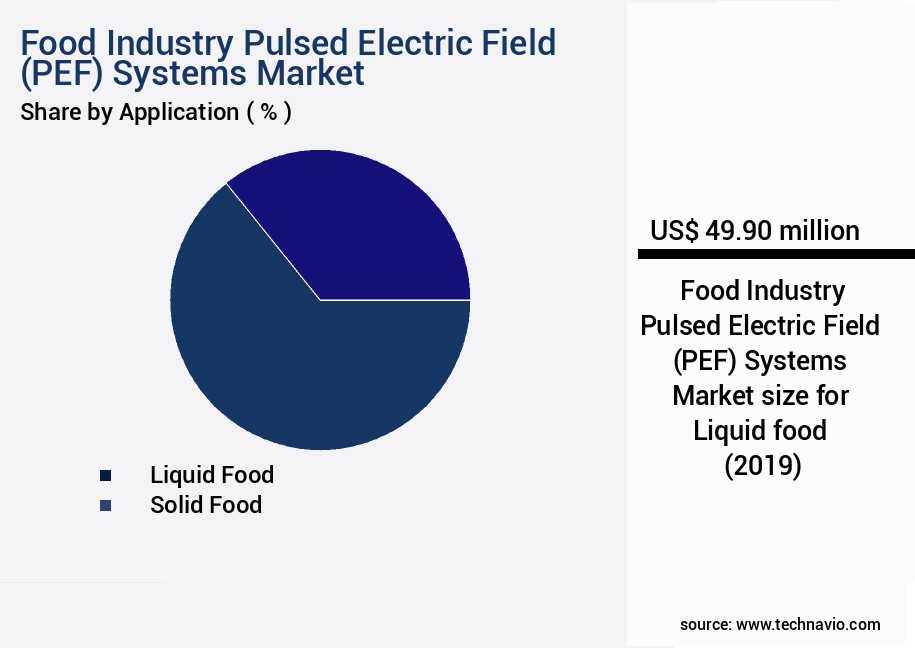
Request Free Sample
The Liquid food segment was valued at USD 49.90 billion in 2019 and showed a gradual increase during the forecast period.
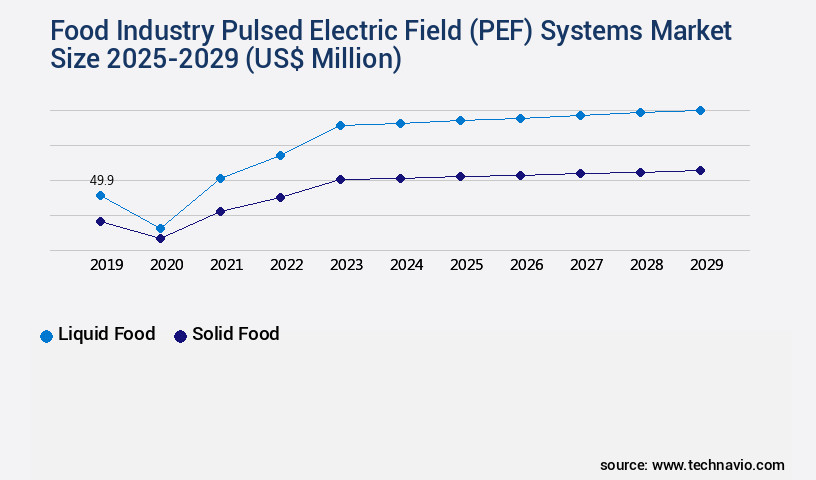
Request Free Sample
Regional Analysis
Europe is estimated to contribute 54% to the growth of the global market during the forecast period.Technavio's analysts have elaborately explained the regional trends and drivers that shape the market during the forecast period.
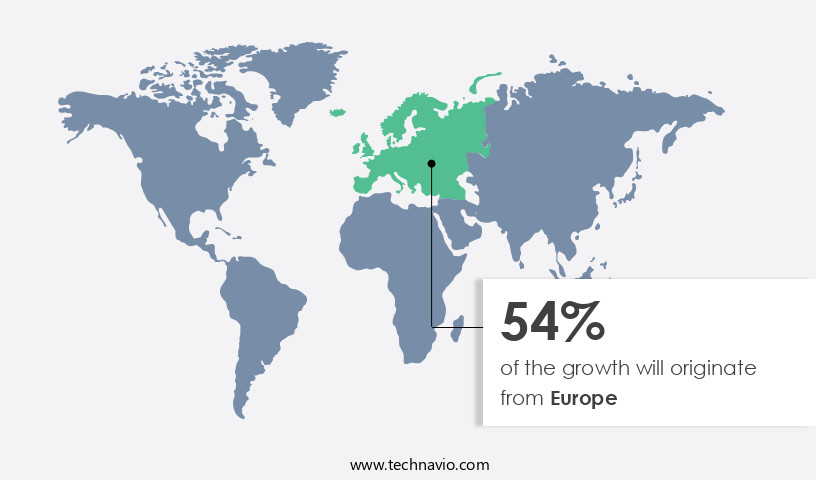
See How Food Industry Pulsed Electric Field (PEF) Systems Market Demand is Rising in Europe Request Free Sample
Europe's Food Industry PEF Systems Market witnessed significant expansion in 2024, driven by the increasing preference for convenient and swiftly prepared food. Europe is a major consumer of processed fruits and vegetables, making it one of the largest markets for PEF systems. These systems are primarily employed for cell membrane permeabilization in fruit and vegetable processing. Notably, Germany, France, Belgium, and the UK are major importers and consumers of processed fruits and vegetables in Europe. The utilization of PEF technology in food processing offers several advantages, such as improved product quality, increased shelf life, and reduced processing time.
Furthermore, the convenience food sector's growth is expected to continue fueling market growth. The European market for PEF systems in food processing is poised for continued expansion, underpinned by the region's demand for processed fruits and vegetables.
Market Dynamics
Our researchers analyzed the data with 2024 as the base year, along with the key drivers, trends, and challenges. A holistic analysis of drivers will help companies refine their marketing strategies to gain a competitive advantage.
The global food industry is witnessing growing adoption of pulsed electric field systems as an innovative, non-thermal processing technology that improves efficiency and product quality. Developments in pef system dielectric properties and analysis of the effect electric field strength are critical to understanding how energy transfer impacts safety and performance. Research into pulse waveform food quality confirms that carefully designed treatment profiles preserve taste, color, and nutrients. Advances in high voltage pulse generator design and capacitor bank energy storage pef are improving reliability, while integration of continuous flow system design pef alongside batch process scalability pef is enabling flexibility for both industrial and small-scale operations.
Applications extend to critical safety processes, with proven improvements in microbial inactivation kinetics pef and reductions in contamination through enzyme activity inactivation pef, aligning with stricter food safety regulations pef. Manufacturers apply process validation methodology pef to ensure compliance, while economic feasibility analysis pef and environmental impact assessment pef confirm the balance between operational cost efficiency and sustainability. Operational resilience is supported through structured pef system maintenance procedures, routine cleaning sanitation protocols pef, and intelligent process automation strategies pef.
Data-driven methods such as data acquisition system pef, process modeling techniques pef, and quality control procedures pef are increasingly central to system optimization. Current data shows that PEF adoption has improved microbial reduction efficiency by 35%, significantly exceeding the 22% effectiveness benchmark achieved by traditional heat-based methods. Future market expectations indicate that advanced automation in PEF is projected to contribute a 14% reduction in operational costs, demonstrating a measurable performance gain that supports scalability. This comparison highlights the dual advantage of safety improvements and cost efficiency, making PEF an increasingly strategic technology for the global food sector.
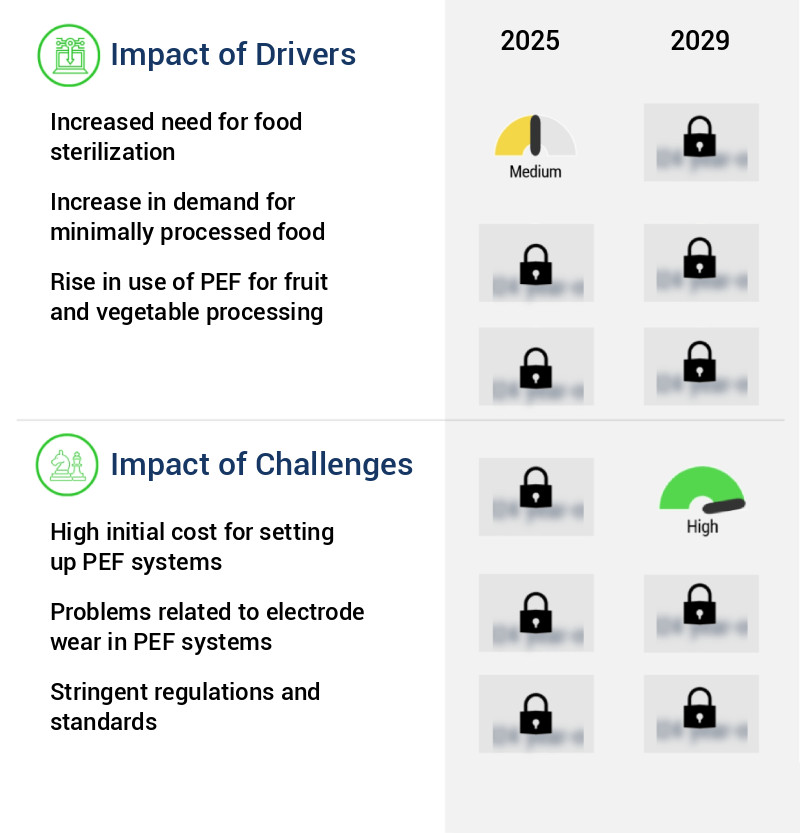
What are the key market drivers leading to the rise in the adoption of Food Industry Pulsed Electric Field (PEF) Systems Industry?
- The significant rise in the demand for food sterilization is the primary market driver. This necessity stems from growing concerns over food safety and the increasing prevalence of foodborne illnesses. The market is witnessing substantial growth as a result.
- The food processing industry continues to innovate, driven by consumer preferences for fresh food, sustainable, and nutritious food products. Sterilization plays a crucial role in ensuring food safety and prolonging shelf life. PEF (Pulsed Electric Field) processing is a cutting-edge sterilization technique gaining popularity due to its effectiveness in eliminating spoilage and pathogenic microorganisms. This method inactivates bacteria and other microbes using high-intensity electric pulses, preserving the food's taste, texture, and nutritional value. The demand for sterilized food products is on the rise, as consumers increasingly seek fresh, durable, and safe options.
- PEF processing offers a solution to this trend, providing a more natural and sustainable alternative to traditional thermal sterilization methods. This technology's adoption is expected to grow significantly, offering opportunities for businesses in the food processing sector.
What are the market trends shaping the Food Industry Pulsed Electric Field (PEF) Systems Industry?
- The introduction of new Professional Development and Education Fund (PEF) systems is a current market trend. It is mandatory for organizations to adopt these advanced systems to remain competitive.
- The global food industry has seen notable advancements in processing technologies, with pulsed electric field (PEF) systems gaining significant attention. Several market players have been introducing new PEF processing systems to cater to the operational needs of various food processors. For example, in recent years, Pulsemaster launched a compact PEF system, engineered for small to mid-scale food processors. This system, capable of processing up to 10 tons per hour, broadens the accessibility of PEF technology, historically confined to larger industrial operations. Designed to treat a diverse range of agricultural products, including vegetables, fruits, and root crops like potatoes and carrots, this compact system marks a substantial development in the PEF market.
- The adoption of PEF technology is on the rise due to its benefits, such as improved food quality, extended shelf life, and reduced processing time. These advancements underscore the dynamic nature of the food industry and the continuous evolution of processing technologies.
What challenges does the Food Industry Pulsed Electric Field (PEF) Systems Industry face during its growth?
- The high initial cost of establishing Pharmacy Benefit Manager (PEF) systems poses a significant challenge to the industry's growth, as it requires substantial investment for implementation and integration with existing healthcare infrastructure.
- In the food and beverage processing industry, Pulsed Electric Field (PEF) technology has emerged as a preferred non-thermal processing method due to its advantages in preserving the nutritional value and sensory qualities of food products. However, the high initial investment for industrial-scale PEF systems poses a significant challenge for many companies. According to industry reports, the cost of installing an industrial PEF system is substantially higher than a commercial-scale one. For instance, Diversified Technologies provides industrial PEF systems priced at approximately USD295,000. The high-pulse voltage generator, a critical component of the PEF system, has an average lifespan of around five years with a daily operation capacity of 20 hours.
- The need for periodic generator replacements adds to the operational costs. Despite these expenses, the potential benefits of PEF technology, such as improved product quality, extended shelf life, and reduced water usage, make it an attractive option for forward-thinking food and beverage processors.
Exclusive Customer Landscape
The food industry pulsed electric field (pef) systems market forecasting report includes the adoption lifecycle of the market, covering from the innovator's stage to the laggard's stage. It focuses on adoption rates in different regions based on penetration. Furthermore, the food industry pulsed electric field (pef) systems market report also includes key purchase criteria and drivers of price sensitivity to help companies evaluate and develop their market growth analysis strategies.
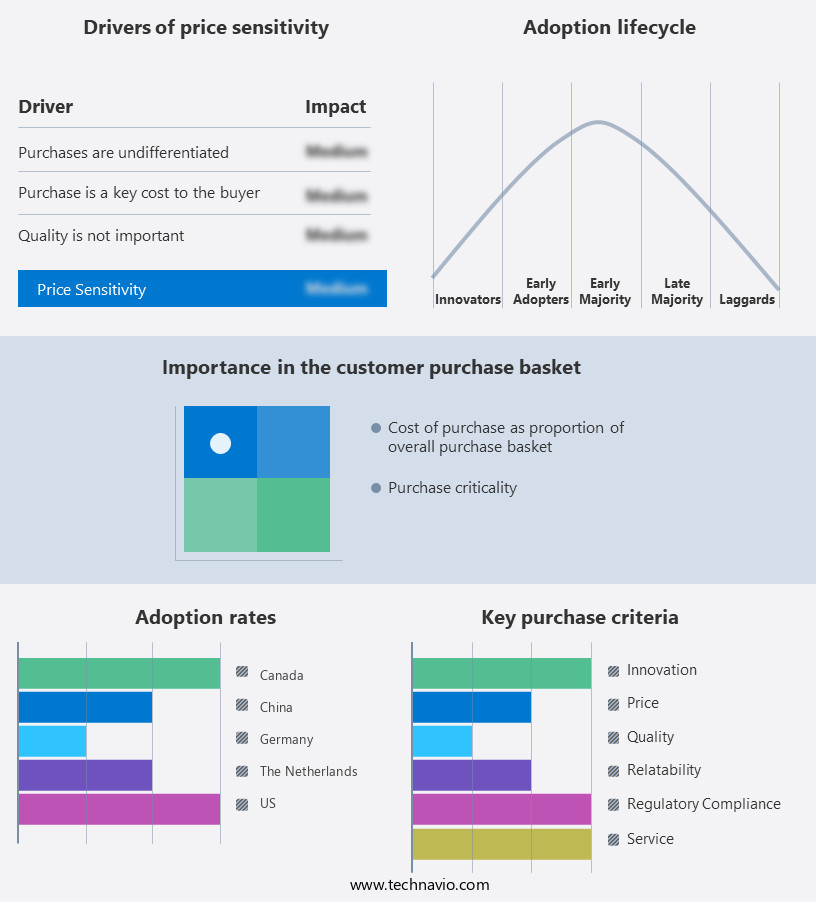
Customer Landscape of Food Industry Pulsed Electric Field (PEF) Systems Industry
Competitive Landscape & Market Insights
Companies are implementing various strategies, such as strategic alliances, food industry pulsed electric field (pef) systems market forecast, partnerships, mergers and acquisitions, geographical expansion, and product/service launches, to enhance their presence in the industry.
Bertuzzi Food Processing Srl - Pulsed Electric Field (PEF) technology, utilized by numerous firms globally, enhances fruit processing efficiency. This non-thermal method boosts juice yield and inhibits enzymatic browning, thereby preserving fruit quality. By applying short, high-voltage electric pulses, PEF systems disrupt cell membranes, facilitating the release of juice and enzymes, while minimizing oxidation. This technology's adoption is anticipated to revolutionize the fruit processing industry.
The industry research and growth report includes detailed analyses of the competitive landscape of the market and information about key companies, including:
- Bertuzzi Food Processing Srl
- Diversified Technologies Inc.
- Elea
- Energy Pulse Systems
- Food Physics LLC
- Gungunwala Food Equipment Pvt. Ltd.
- Heat and Control Inc.
- Hiperbaric S.A.
- Hydro-Thermal Corporation
- John Bean Technologies Corp.
- KayDee Solutions
- PEF Technologies B.V.
- Proxes GmbH
- Pulsemaster
- ScandiNova Systems AB
Qualitative and quantitative analysis of companies has been conducted to help clients understand the wider business environment as well as the strengths and weaknesses of key industry players. Data is qualitatively analyzed to categorize companies as pure play, category-focused, industry-focused, and diversified; it is quantitatively analyzed to categorize companies as dominant, leading, strong, tentative, and weak.
Recent Development and News in Food Industry Pulsed Electric Field (PEF) Systems Market
- In January 2024, Tetra Pak, a leading food processing and packaging solutions company, announced the launch of its new Pulsed Electric Field (PEF) technology for juice and liquid food applications (Tetra Pak Press Release, 2024). This innovation enables improved microbial reduction, extended shelf life, and enhanced product quality.
- In March 2024, Döhler, a global ingredient solutions provider, entered into a strategic partnership with Peftec, a specialist in PEF technology, to expand its portfolio and cater to the growing demand for clean-label and minimally processed food products (Döhler Press Release, 2024).
- In May 2025, Chirag Exports, an Indian food processing company, raised USD15 million in funding to invest in a new PEF-based food processing plant, expanding its market presence and capacity to cater to both domestic and international markets (Business Standard, 2025).
- In the same month, the European Food Safety Authority (EFSA) approved the use of PEF technology as a processing method for various food products, paving the way for its widespread adoption in the European food industry (EFSA Journal, 2025).
Dive into Technavio's robust research methodology, blending expert interviews, extensive data synthesis, and validated models for unparalleled Food Industry Pulsed Electric Field (PEF) Systems Market insights. See full methodology.
|
Market Scope
|
|
Report Coverage
|
Details
|
|
Page number
|
217
|
|
Base year
|
2024
|
|
Historic period
|
2019-2023 |
|
Forecast period
|
2025-2029
|
|
Growth momentum & CAGR
|
Accelerate at a CAGR of 45.7%
|
|
Market growth 2025-2029
|
USD 1352.6 million
|
|
Market structure
|
Concentrated
|
|
YoY growth 2024-2025(%)
|
38.7
|
|
Key countries
|
US, Germany, China, France, Canada, UK, Japan, Brazil, South Korea, and Italy
|
|
Competitive landscape
|
Leading Companies, Market Positioning of Companies, Competitive Strategies, and Industry Risks
|
Request Free Sample
Research Analyst Overview
- The pulsed electric field (PEF) systems market encompasses a range of applications, primarily in the food industry. One significant sector is the use of PEF technology in capacitor bank systems for vegetable processing. This method employs batch processing, enabling the reduction of microbial loads and enhancing product quality. In juice processing, PEF systems have shown promise for pathogen inactivation and preserving sensory attributes, while maintaining nutritional value. Continuous flow PEF processing is another evolving trend, offering increased efficiency and scalability. PEF system design is a critical factor in optimizing energy efficiency and waste reduction.
- Pulse waveform parameters, such as electrical field strength and pulse duration, significantly impact the process's effectiveness. Safety regulations continue to shape the PEF market, with food safety being a primary concern. Cost effectiveness and process optimization are also essential considerations, driving the development of high-voltage pulse generators and optimized treatment chamber designs. Microbial inactivation and enzyme activity are key benefits of PEF technology in milk processing. Fruit preservation is another growing application, with membrane permeabilization playing a crucial role in non-thermal processing and cell disruption. Electroporation effects and treatment chamber design are essential aspects of PEF process validation.
- The ongoing advancements in PEF technology demonstrate its potential to revolutionize food processing, offering improved product quality, enhanced safety, and increased efficiency.
What are the Key Data Covered in this Food Industry Pulsed Electric Field (PEF) Systems Market Research and Growth Report?
-
What is the expected growth of the Food Industry Pulsed Electric Field (PEF) Systems Market between 2025 and 2029?
-
What segmentation does the market report cover?
-
The report segmented by Application (Liquid food and Solid food), Type (30-50 kV/cm and 10-30 kV/cm), End-user (Food processing companies, Beverage manufacturers, Dairy producers, Meat and seafood processors, and Fruit and vegetable packers), and Geography (Europe, North America, APAC, South America, and Middle East and Africa)
-
Which regions are analyzed in the report?
-
Europe, North America, APAC, South America, and Middle East and Africa
-
What are the key growth drivers and market challenges?
-
Who are the major players in the Food Industry Pulsed Electric Field (PEF) Systems Market?
-
Key Companies Bertuzzi Food Processing Srl, Diversified Technologies Inc., Elea, Energy Pulse Systems, Food Physics LLC, Gungunwala Food Equipment Pvt. Ltd., Heat and Control Inc., Hiperbaric S.A., Hydro-Thermal Corporation, John Bean Technologies Corp., KayDee Solutions, PEF Technologies B.V., Proxes GmbH, Pulsemaster, and ScandiNova Systems AB
Market Research Insights
- The market encompasses advanced technologies utilized for various food processing applications. Two significant aspects of PEF systems are process monitoring and automation. Pulse duration control and pulse repetition frequency are crucial parameters in optimizing these systems. For instance, a study indicates that a pulse duration of 10 microseconds at a frequency of 1 Hz can achieve effective microbial inactivation. In contrast, a pilot scale PEF system may employ a pulse duration of 20 microseconds and a frequency of 5 Hz for spore inactivation, demonstrating the flexibility and adaptability of PEF systems in addressing diverse food processing requirements. Economic feasibility and environmental impact are also critical considerations in the commercialization of PEF systems.
- For example, energy consumption can be minimized through process modeling and optimization, while maintenance costs can be reduced through efficient system design and quality control measures. These factors contribute to the ongoing evolution and growth of the PEF systems market.
We can help! Our analysts can customize this food industry pulsed electric field (pef) systems market research report to meet your requirements.
Get in touch
1 Executive Summary
- 1.1 Market overview
- Executive Summary - Chart on Market Overview
- Executive Summary - Data Table on Market Overview
- Executive Summary - Chart on Global Market Characteristics
- Executive Summary - Chart on Market by Geography
- Executive Summary - Chart on Market Segmentation by Application
- Executive Summary - Chart on Market Segmentation by Type
- Executive Summary - Chart on Market Segmentation by End-user
- Executive Summary - Chart on Incremental Growth
- Executive Summary - Data Table on Incremental Growth
- Executive Summary - Chart on Company Market Positioning
2 Technavio Analysis
- 2.1 Analysis of price sensitivity, lifecycle, customer purchase basket, adoption rates, and purchase criteria
- Analysis of price sensitivity, lifecycle, customer purchase basket, adoption rates, and purchase criteria
- 2.2 Criticality of inputs and Factors of differentiation
- Overview on criticality of inputs and factors of differentiation
- 2.3 Factors of disruption
- Overview on factors of disruption
- 2.4 Impact of drivers and challenges
- Impact of drivers and challenges in 2024 and 2029
3 Market Landscape
- 3.1 Market ecosystem
- Parent Market
- Data Table on - Parent Market
- 3.2 Market characteristics
- Market characteristics analysis
4 Market Sizing
- 4.1 Market definition
- Offerings of companies included in the market definition
- 4.2 Market segment analysis
- 4.4 Market outlook: Forecast for 2024-2029
- Chart on Global - Market size and forecast 2024-2029 ($ million)
- Data Table on Global - Market size and forecast 2024-2029 ($ million)
- Chart on Global Market: Year-over-year growth 2024-2029 (%)
- Data Table on Global Market: Year-over-year growth 2024-2029 (%)
5 Historic Market Size
- 5.1 Global Food Industry Pulsed Electric Field (PEF) Systems Market 2019 - 2023
- Historic Market Size - Data Table on Global Food Industry Pulsed Electric Field (PEF) Systems Market 2019 - 2023 ($ million)
- 5.2 Application segment analysis 2019 - 2023
- Historic Market Size - Application Segment 2019 - 2023 ($ million)
- 5.3 Type segment analysis 2019 - 2023
- Historic Market Size - Type Segment 2019 - 2023 ($ million)
- 5.4 End-user segment analysis 2019 - 2023
- Historic Market Size - End-user Segment 2019 - 2023 ($ million)
- 5.5 Geography segment analysis 2019 - 2023
- Historic Market Size - Geography Segment 2019 - 2023 ($ million)
- 5.6 Country segment analysis 2019 - 2023
- Historic Market Size - Country Segment 2019 - 2023 ($ million)
6 Qualitative Analysis
- 6.1 The AI impact on global food industry pulsed electric field (PEF) systems market
7 Five Forces Analysis
- 7.1 Five forces summary
- Five forces analysis - Comparison between 2024 and 2029
- 7.2 Bargaining power of buyers
- Bargaining power of buyers - Impact of key factors 2024 and 2029
- 7.3 Bargaining power of suppliers
- Bargaining power of suppliers - Impact of key factors in 2024 and 2029
- 7.4 Threat of new entrants
- Threat of new entrants - Impact of key factors in 2024 and 2029
- 7.5 Threat of substitutes
- Threat of substitutes - Impact of key factors in 2024 and 2029
- 7.6 Threat of rivalry
- Threat of rivalry - Impact of key factors in 2024 and 2029
- 7.7 Market condition
- Chart on Market condition - Five forces 2024 and 2029
8 Market Segmentation by Application
- 8.1 Market segments
- Chart on Application - Market share 2024-2029 (%)
- Data Table on Application - Market share 2024-2029 (%)
- 8.2 Comparison by Application
- Chart on Comparison by Application
- Data Table on Comparison by Application
- 8.3 Liquid food - Market size and forecast 2024-2029
- Chart on Liquid food - Market size and forecast 2024-2029 ($ million)
- Data Table on Liquid food - Market size and forecast 2024-2029 ($ million)
- Chart on Liquid food - Year-over-year growth 2024-2029 (%)
- Data Table on Liquid food - Year-over-year growth 2024-2029 (%)
- 8.4 Solid food - Market size and forecast 2024-2029
- Chart on Solid food - Market size and forecast 2024-2029 ($ million)
- Data Table on Solid food - Market size and forecast 2024-2029 ($ million)
- Chart on Solid food - Year-over-year growth 2024-2029 (%)
- Data Table on Solid food - Year-over-year growth 2024-2029 (%)
- 8.5 Market opportunity by Application
- Market opportunity by Application ($ million)
- Data Table on Market opportunity by Application ($ million)
9 Market Segmentation by Type
- 9.1 Market segments
- Chart on Type - Market share 2024-2029 (%)
- Data Table on Type - Market share 2024-2029 (%)
- 9.2 Comparison by Type
- Chart on Comparison by Type
- Data Table on Comparison by Type
- 30-50 kV/cm - Market size and forecast 2024-2029
- Chart on 30-50 kV/cm - Market size and forecast 2024-2029 ($ million)
- Data Table on 30-50 kV/cm - Market size and forecast 2024-2029 ($ million)
- Chart on 30-50 kV/cm - Year-over-year growth 2024-2029 (%)
- Data Table on 30-50 kV/cm - Year-over-year growth 2024-2029 (%)
- 10-30 kV/cm - Market size and forecast 2024-2029
- Chart on 10-30 kV/cm - Market size and forecast 2024-2029 ($ million)
- Data Table on 10-30 kV/cm - Market size and forecast 2024-2029 ($ million)
- Chart on 10-30 kV/cm - Year-over-year growth 2024-2029 (%)
- Data Table on 10-30 kV/cm - Year-over-year growth 2024-2029 (%)
- 9.5 Market opportunity by Type
- Market opportunity by Type ($ million)
- Data Table on Market opportunity by Type ($ million)
10 Market Segmentation by End-user
- 10.1 Market segments
- Chart on End-user - Market share 2024-2029 (%)
- Data Table on End-user - Market share 2024-2029 (%)
- 10.2 Comparison by End-user
- Chart on Comparison by End-user
- Data Table on Comparison by End-user
- 10.3 Food processing companies - Market size and forecast 2024-2029
- Chart on Food processing companies - Market size and forecast 2024-2029 ($ million)
- Data Table on Food processing companies - Market size and forecast 2024-2029 ($ million)
- Chart on Food processing companies - Year-over-year growth 2024-2029 (%)
- Data Table on Food processing companies - Year-over-year growth 2024-2029 (%)
- 10.4 Beverage manufacturers - Market size and forecast 2024-2029
- Chart on Beverage manufacturers - Market size and forecast 2024-2029 ($ million)
- Data Table on Beverage manufacturers - Market size and forecast 2024-2029 ($ million)
- Chart on Beverage manufacturers - Year-over-year growth 2024-2029 (%)
- Data Table on Beverage manufacturers - Year-over-year growth 2024-2029 (%)
- 10.5 Dairy producers - Market size and forecast 2024-2029
- Chart on Dairy producers - Market size and forecast 2024-2029 ($ million)
- Data Table on Dairy producers - Market size and forecast 2024-2029 ($ million)
- Chart on Dairy producers - Year-over-year growth 2024-2029 (%)
- Data Table on Dairy producers - Year-over-year growth 2024-2029 (%)
- 10.6 Meat and seafood processors - Market size and forecast 2024-2029
- Chart on Meat and seafood processors - Market size and forecast 2024-2029 ($ million)
- Data Table on Meat and seafood processors - Market size and forecast 2024-2029 ($ million)
- Chart on Meat and seafood processors - Year-over-year growth 2024-2029 (%)
- Data Table on Meat and seafood processors - Year-over-year growth 2024-2029 (%)
- 10.7 Fruit and vegetable packers - Market size and forecast 2024-2029
- Chart on Fruit and vegetable packers - Market size and forecast 2024-2029 ($ million)
- Data Table on Fruit and vegetable packers - Market size and forecast 2024-2029 ($ million)
- Chart on Fruit and vegetable packers - Year-over-year growth 2024-2029 (%)
- Data Table on Fruit and vegetable packers - Year-over-year growth 2024-2029 (%)
- 10.8 Market opportunity by End-user
- Market opportunity by End-user ($ million)
- Data Table on Market opportunity by End-user ($ million)
11 Customer Landscape
- 11.1 Customer landscape overview
- Analysis of price sensitivity, lifecycle, customer purchase basket, adoption rates, and purchase criteria
12 Geographic Landscape
- 12.1 Geographic segmentation
- Chart on Market share by geography 2024-2029 (%)
- Data Table on Market share by geography 2024-2029 (%)
- 12.2 Geographic comparison
- Chart on Geographic comparison
- Data Table on Geographic comparison
- 12.3 Europe - Market size and forecast 2024-2029
- Chart on Europe - Market size and forecast 2024-2029 ($ million)
- Data Table on Europe - Market size and forecast 2024-2029 ($ million)
- Chart on Europe - Year-over-year growth 2024-2029 (%)
- Data Table on Europe - Year-over-year growth 2024-2029 (%)
- 12.4 North America - Market size and forecast 2024-2029
- Chart on North America - Market size and forecast 2024-2029 ($ million)
- Data Table on North America - Market size and forecast 2024-2029 ($ million)
- Chart on North America - Year-over-year growth 2024-2029 (%)
- Data Table on North America - Year-over-year growth 2024-2029 (%)
- 12.5 APAC - Market size and forecast 2024-2029
- Chart on APAC - Market size and forecast 2024-2029 ($ million)
- Data Table on APAC - Market size and forecast 2024-2029 ($ million)
- Chart on APAC - Year-over-year growth 2024-2029 (%)
- Data Table on APAC - Year-over-year growth 2024-2029 (%)
- 12.6 South America - Market size and forecast 2024-2029
- Chart on South America - Market size and forecast 2024-2029 ($ million)
- Data Table on South America - Market size and forecast 2024-2029 ($ million)
- Chart on South America - Year-over-year growth 2024-2029 (%)
- Data Table on South America - Year-over-year growth 2024-2029 (%)
- 12.7 Middle East and Africa - Market size and forecast 2024-2029
- Chart on Middle East and Africa - Market size and forecast 2024-2029 ($ million)
- Data Table on Middle East and Africa - Market size and forecast 2024-2029 ($ million)
- Chart on Middle East and Africa - Year-over-year growth 2024-2029 (%)
- Data Table on Middle East and Africa - Year-over-year growth 2024-2029 (%)
- 12.8 US - Market size and forecast 2024-2029
- Chart on US - Market size and forecast 2024-2029 ($ million)
- Data Table on US - Market size and forecast 2024-2029 ($ million)
- Chart on US - Year-over-year growth 2024-2029 (%)
- Data Table on US - Year-over-year growth 2024-2029 (%)
- 12.9 Germany - Market size and forecast 2024-2029
- Chart on Germany - Market size and forecast 2024-2029 ($ million)
- Data Table on Germany - Market size and forecast 2024-2029 ($ million)
- Chart on Germany - Year-over-year growth 2024-2029 (%)
- Data Table on Germany - Year-over-year growth 2024-2029 (%)
- 12.10 Canada - Market size and forecast 2024-2029
- Chart on Canada - Market size and forecast 2024-2029 ($ million)
- Data Table on Canada - Market size and forecast 2024-2029 ($ million)
- Chart on Canada - Year-over-year growth 2024-2029 (%)
- Data Table on Canada - Year-over-year growth 2024-2029 (%)
- 12.11 France - Market size and forecast 2024-2029
- Chart on France - Market size and forecast 2024-2029 ($ million)
- Data Table on France - Market size and forecast 2024-2029 ($ million)
- Chart on France - Year-over-year growth 2024-2029 (%)
- Data Table on France - Year-over-year growth 2024-2029 (%)
- 12.12 China - Market size and forecast 2024-2029
- Chart on China - Market size and forecast 2024-2029 ($ million)
- Data Table on China - Market size and forecast 2024-2029 ($ million)
- Chart on China - Year-over-year growth 2024-2029 (%)
- Data Table on China - Year-over-year growth 2024-2029 (%)
- 12.13 UK - Market size and forecast 2024-2029
- Chart on UK - Market size and forecast 2024-2029 ($ million)
- Data Table on UK - Market size and forecast 2024-2029 ($ million)
- Chart on UK - Year-over-year growth 2024-2029 (%)
- Data Table on UK - Year-over-year growth 2024-2029 (%)
- 12.14 Japan - Market size and forecast 2024-2029
- Chart on Japan - Market size and forecast 2024-2029 ($ million)
- Data Table on Japan - Market size and forecast 2024-2029 ($ million)
- Chart on Japan - Year-over-year growth 2024-2029 (%)
- Data Table on Japan - Year-over-year growth 2024-2029 (%)
- 12.15 South Korea - Market size and forecast 2024-2029
- Chart on South Korea - Market size and forecast 2024-2029 ($ million)
- Data Table on South Korea - Market size and forecast 2024-2029 ($ million)
- Chart on South Korea - Year-over-year growth 2024-2029 (%)
- Data Table on South Korea - Year-over-year growth 2024-2029 (%)
- 12.16 Italy - Market size and forecast 2024-2029
- Chart on Italy - Market size and forecast 2024-2029 ($ million)
- Data Table on Italy - Market size and forecast 2024-2029 ($ million)
- Chart on Italy - Year-over-year growth 2024-2029 (%)
- Data Table on Italy - Year-over-year growth 2024-2029 (%)
- 12.17 Brazil - Market size and forecast 2024-2029
- Chart on Brazil - Market size and forecast 2024-2029 ($ million)
- Data Table on Brazil - Market size and forecast 2024-2029 ($ million)
- Chart on Brazil - Year-over-year growth 2024-2029 (%)
- Data Table on Brazil - Year-over-year growth 2024-2029 (%)
- 12.18 Market opportunity by geography
- Market opportunity by geography ($ million)
- Data Tables on Market opportunity by geography ($ million)
13 Drivers, Challenges, and Opportunity/Restraints
- 13.3 Impact of drivers and challenges
- Impact of drivers and challenges in 2024 and 2029
- 13.4 Market opportunities/restraints
14 Competitive Landscape
- 14.2 Competitive Landscape
- Overview on criticality of inputs and factors of differentiation
- 14.3 Landscape disruption
- Overview on factors of disruption
- 14.4 Industry risks
- Impact of key risks on business
15 Competitive Analysis
- 15.2 Company ranking index
- 15.3 Market positioning of companies
- Matrix on companies position and classification
- 15.4 Bertuzzi Food Processing Srl
- Bertuzzi Food Processing Srl - Overview
- Bertuzzi Food Processing Srl - Product / Service
- Bertuzzi Food Processing Srl - Key offerings
- SWOT
- 15.5 Diversified Technologies Inc.
- Diversified Technologies Inc. - Overview
- Diversified Technologies Inc. - Product / Service
- Diversified Technologies Inc. - Key offerings
- SWOT
- 15.6 Elea
- Elea - Overview
- Elea - Product / Service
- Elea - Key offerings
- SWOT
- 15.7 Energy Pulse Systems
- Energy Pulse Systems - Overview
- Energy Pulse Systems - Product / Service
- Energy Pulse Systems - Key offerings
- SWOT
- 15.8 Food Physics LLC
- Food Physics LLC - Overview
- Food Physics LLC - Product / Service
- Food Physics LLC - Key offerings
- SWOT
- 15.9 Gungunwala Food Equipment Pvt. Ltd.
- Gungunwala Food Equipment Pvt. Ltd. - Overview
- Gungunwala Food Equipment Pvt. Ltd. - Product / Service
- Gungunwala Food Equipment Pvt. Ltd. - Key offerings
- SWOT
- 15.10 Heat and Control Inc.
- Heat and Control Inc. - Overview
- Heat and Control Inc. - Product / Service
- Heat and Control Inc. - Key offerings
- SWOT
- 15.11 Hiperbaric S.A.
- Hiperbaric S.A. - Overview
- Hiperbaric S.A. - Product / Service
- Hiperbaric S.A. - Key offerings
- SWOT
- 15.12 Hydro-Thermal Corporation
- Hydro-Thermal Corporation - Overview
- Hydro-Thermal Corporation - Product / Service
- Hydro-Thermal Corporation - Key offerings
- SWOT
- 15.13 John Bean Technologies Corp.
- John Bean Technologies Corp. - Overview
- John Bean Technologies Corp. - Business segments
- John Bean Technologies Corp. - Key offerings
- John Bean Technologies Corp. - Segment focus
- SWOT
- 15.14 KayDee Solutions
- KayDee Solutions - Overview
- KayDee Solutions - Product / Service
- KayDee Solutions - Key offerings
- SWOT
- 15.15 PEF Technologies B.V.
- PEF Technologies B.V. - Overview
- PEF Technologies B.V. - Product / Service
- PEF Technologies B.V. - Key offerings
- SWOT
- 15.16 Proxes GmbH
- Proxes GmbH - Overview
- Proxes GmbH - Product / Service
- Proxes GmbH - Key offerings
- SWOT
- 15.17 Pulsemaster
- Pulsemaster - Overview
- Pulsemaster - Product / Service
- Pulsemaster - Key offerings
- SWOT
- 15.18 ScandiNova Systems AB
- ScandiNova Systems AB - Overview
- ScandiNova Systems AB - Product / Service
- ScandiNova Systems AB - Key offerings
- SWOT
16 Appendix
- 16.2 Inclusions and exclusions checklist
- Inclusions checklist
- Exclusions checklist
- 16.3 Currency conversion rates for US$
- Currency conversion rates for US$
- 16.4 Research methodology
- 16.7 Validation techniques employed for market sizing
- Validation techniques employed for market sizing
- 16.9 360 degree market analysis
- 360 degree market analysis
- 16.10 List of abbreviations







![]() Get the report (PDF) sent to your email within minutes.
Get the report (PDF) sent to your email within minutes.
Complimentary full Excel data with your report purchase.